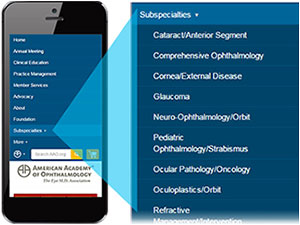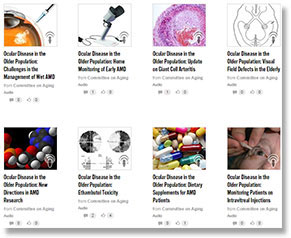Download PDF
WHAT’S HAPPENING
Academy Unveils Revamped Website
Have you discovered all the new features of the rebuilt Academy website (www.aao.org), launched last April? Based on extensive usability testing and interviews with members, it is tailored to address ophthalmologists’ individual needs. For example, it is designed to read and navigate easily on smartphones, tablets, and desktops; has easier login and more intuitive navigation for faster access to the content you want; and offers expanded advocacy content as well as new subspecialty pages that include clinical news, peer discussions, jobs, and more.
 |
| STREAMLINED NAVIGATION. Popular areas such as annual meeting, clinical education, and practice management take center stage on the redesigned www.aao.org. The brand-new subspecialty pages are also emphasized. |
For a more seamless experience, formerly discrete sections such as the Foundation of the American Academy of Ophthalmology and the Ophthalmic News & Education (ONE) Network now are integrated into the new www.aao.org, which houses the following:
- New subspecialty landing pages, populated with content from EyeNet, Ophthalmology, and the ONE Network
- Clinical education content powered by the ONE Network
- The Intelligent Research in Sight (IRIS) Registry
- A significantly expanded AAOE practice management portal
- An expanded governmental affairs and health policy section
- A vast network of services for Academy members, including subscription management, downloadable Academy logos, and award applications
- Eye health information and services for the public
- Enhanced engagement capabilities including the Academy Forum (formerly the Online Community)
For more information, visit www.aao.org/new-site-intro.
|
 ONE SPOTLIGHT: Experts discuss new strategies for elderly patient care. The Ocular Disease in the Older Population podcast series from the Academy Committee on Aging features experts discussing their clinical experiences with older adults and how this differs from caring for younger patients. Recent additions to the series include New Directions in AMD Research, Home Monitoring of Early AMD, Challenges in the Management of Wet AMD, Update on Giant Cell Arteritis, and Visual Field Defects in the Elderly. ONE SPOTLIGHT: Experts discuss new strategies for elderly patient care. The Ocular Disease in the Older Population podcast series from the Academy Committee on Aging features experts discussing their clinical experiences with older adults and how this differs from caring for younger patients. Recent additions to the series include New Directions in AMD Research, Home Monitoring of Early AMD, Challenges in the Management of Wet AMD, Update on Giant Cell Arteritis, and Visual Field Defects in the Elderly.
To listen to these podcasts, visit www.aao.org/browse-multimedia?filter=audio.
|
TAKE NOTICE
PQRS: Aug. 1 Deadline for Cataracts Measures Group
If you do not have electronic health records (EHR), what’s the easiest way to participate in the Physician Quality Reporting System (PQRS)?
If you perform cataract surgery, you can report the Cataracts Measures Group by manually entering data into the IRIS Registry Web portal. You’ll need to report 8 predetermined measures for 20 patients (11 of whom must be Medicare Part B). However, you must meet the following deadlines:
- By Aug. 1, submit your signed IRIS Registry agreements.
- By Sept. 30, provide preoperative surveys and perform cataract surgery on 20 patients meeting the selection criteria.
- By Dec. 1, submit signed consent allowing data to be sent to CMS.
- By Jan. 15, 2016, complete the rest of the Cataracts Measures Group reporting and submit data to the IRIS Registry.
If you don’t perform cataract surgery, you can report PQRS individual measures via the IRIS Registry (see this month’s Practice Perfect).
If you do have EHR, the deadline for signing up to integrate your system with the IRIS Registry in 2015 has already passed; if you met that deadline, you must get your system mapped to the IRIS Registry by Aug. 1.
For more information, visit www.aao.org/irisregistry.
Read the Washington Mid-Year Report
The 2015 Washington Mid-Year Report provides an update on the Academy’s top federal legislative initiatives. The report discusses advocacy efforts in the following areas:
- Repealing the sustainable growth formula
- Preserving surgical global payments
- Preserving patient access to compounded drugs and biologics
- Reducing burdens and penalties associated with the PQRS and EHR meaningful use programs
- Ensuring high-quality eye care in the U.S. Department of Veterans Affairs
To view, visit www.aao.org/advocacy.
CBRs: How to Prepare for an Audit
Comparative billing reports (CBRs) show how a practice’s billing patterns compare to state and national averages. Medicare audit contractors use the same data-mining systems as the CBRs to identify candidates for audit, so if you’ve received a CBR from a Medicare Administrative Contractor, you’ve probably billed outside the norm and could be vulnerable to future audit activity.
The Academy’s new Chart-Auditing Service can help you prepare for this. As part of this service, a coding expert assesses your charts, writes a detailed report and summary evaluation, and calls you to discuss findings and make recommendations.
For more information, visit www.aao.org/audit.
Ask the Ethicist: “Femto-Ethics”
Q: I am considering adding femtosecond cataract surgery to my practice, but I have many questions, including, What training and skills are required? How should I prepare for my first case? Are there specific ethics or medicolegal issues that I should take into consideration?
A: Each of these questions—not just the last one—has an ethics component. Before introducing femtosecond surgery into your practice, consider the applicable rules in the Academy Code of Ethics. These include Rule 1, Competence; Rule 2, Informed Consent; Rule 6, Preoperative Assessment; and Rule 15, Conflict of Interest.
Competence. Rule 1 says, “An ophthalmologist should perform only those procedures in which the ophthalmologist is competent by virtue of specific training or experience or is assisted by one who is.” In the case of femtosecond cataract surgery, a commitment to formal study is strongly recommended. Suggested resources include instruction courses and Skills Transfer sessions at AAO 2015, surgical simulators, slide scripts, video and self-assessment materials, assistance of a skilled mentor, and review of initial cases with a mentor.1
All the femtosecond cataract equipment manufacturers require certification. However, successful completion of training components or objectives does not necessarily signify an individual’s clinical competence in a specific procedure. Components of competency or user proficiency include patient selection; preoperative evaluation and preparation; familiarity with instrumentation; surgical skills and judgment; safe, expeditious completion of the procedure; a postoperative plan; and avoidance of complications.2
Furthermore, hospitals have stringent guidelines governing acquisition of new procedures, usually under the supervision of a senior staff member. Managed care entities may have their own guidelines, and these should also be reviewed carefully.
Informed consent. Rule 2 states, “The performance of medical or surgical procedures shall be preceded by appropriate informed consent.” Most states set a higher standard than Rule 2 by requiring disclosure of all information that a reasonable patient would find significant in deciding to agree to the use of a femtosecond laser, such as whether other options are available (e.g., manual corneal incisions and anterior capsulotomies), and the ophthalmologist’s financial interests in the laser device. The Ophthalmic Mutual Insurance Company offers an informed consent addendum for femtosecond laser use in cataract surgery: www.omic.com/cataract-femtosecond-laser-addendum.
It also may be prudent to contact your liability carrier about your coverage in using this new technology.
Preoperative assessment. The portion of Rule 6 that is most relevant to your situation is as follows: “Treatment shall be recommended only after a careful consideration of the patient’s physical, social, emotional and occupational needs.”
Ethical and quality-of-care standards are met only if the individual patient’s needs are addressed. Your assessment of the patient should be based on what is in the patient’s best interests—this may be femto, or it may be manual procedures. With femto, the patient’s financial situation is a significant part of this assessment.
To give yourself the best chance of successful outcome with your first case, appropriate patient selection is a particularly important factor. Patient selection should initially be made on the basis of anticipated technical difficulty. The patient’s personality should also be considered; anxiety, impatience, or a demanding nature may not make for a suitable candidate.
Conflict of interest. Rule 15 says, “A conflict of interest exists when professional judgment concerning the well-being of the patient has a reasonable chance of being influenced by other interests of the provider. Disclosure of a conflict of interest is required in communications to patients, the public, and colleagues.”
When an ophthalmic surgeon has a professionally related commercial interest, such as the ownership or part ownership of a femtosecond laser device, the potential exists for a conflict of interest in patient care. It is essential that conflicting commercial interests related to the laser device be disclosed to the patient, unless it is apparent to a reasonable person that the device is an integral part of the ophthalmologist’s practice facility and hence is likely to be owned in whole or in part by the ophthalmologist or the practice.
Most patients would likely be unaware that a laser device is owned by an individual or a practice and that each use of the laser produces income for the individual or practice, so it is wise to disclose this.
For more information, visit www.aao.org/ethics.
___________________________
1 Sachdeva AK et al. Surg Clin North Am. 2007;87(4):853-866.
2 www.sages.org/publications/guidelines/framework-for-post-residency-surgical-education-training. Accessed May 5, 2015.
D.C. REPORT
SGR Repeal Aftermath
The repeal of the sustainable growth rate (SGR) formula marked the end of a failed health care policy. The “doc fix” bill will result in positive fee schedule updates for physicians and stability for practices that are dependent on Medicare revenues. However, the “doc fix” bill, officially called the Medicare Access and CHIP Reauthorization Act of 2015, is imperfect—payment increases are inadequate, and the new merit-based incentive system introduces fresh complexities. It also doesn’t kick in until 2019, so doctors’ challenges with the current program will linger.
The new law benefits ophthalmologists in several ways, including the following:
- Payment updates will be stable.
- Specialists will not subsidize a higher update for primary care doctors.
- Doctors who do not move to alternative payment models will not be penalized.
- Penalties under the Medicare value-based purchasing system are lower.
- The new program reinstates performance bonuses.
- The merit-based system gives medicine a say in defining quality standards.
- Emphasis on clinical data registries in the merit system may relieve doctors of some reporting burdens.
The Academy has the following concerns about the law:
- Payment updates are inadequate.
- Uncertainties and added complexity cloud the new merit-based system.
- Penalties and rewards based on resources a physician uses cannot adequately differentiate between specialties and subspecialties.
For the Academy’s latest coverage of SGR repeal, visit www.aao.org/advocacy/sustain able-growth-rate. Also see the Current Perspective in the June 2015 EyeNet.
ACADEMY STORE
New Textbook Editions With Video
Build a solid foundation of ophthalmic surgical knowledge with the new Basic Principles of Ophthalmic Surgery, 3rd ed., and Basic Techniques of Ophthalmic Surgery, 2nd ed.
The first of these textbooks introduces residents to key concepts and elements in ophthalmic surgery, including patient selection and preparation, surgical logistics and preparation, materials and instrumentation, and postoperative considerations. This new edition has been expanded to cover topics like surgical complications, and it discusses training requirements from the Accreditation Council for Graduate Medical Education. It also includes 4 videos.
The companion volume, Basic Techniques of Ophthalmic Surgery, describes more than 80 common procedures and explains them step by step, with more than 500 images and 175 videos.
Each volume is available in eBook or print format. Videos can be played in the eBooks or accessed online via the QR codes in the printed books.
For pricing and more information, visit www.aao.org/store.